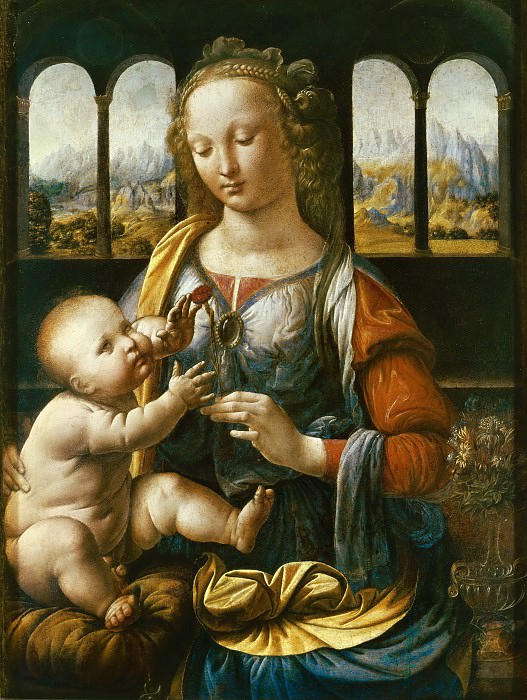Madonna of the Carnation Leonardo da Vinci (1452-1519)
Leonardo da Vinci – Madonna of the Carnation
Edit attribution
Download full size: 2891×3841 px (2,9 Mb)
Painter: Leonardo da Vinci
Leonardo Da Vinci depicted the Madonna with a Flower at a young age. At this time his paintings were influenced by the work of Verrocchio, who was his teacher. This is the artist’s first independent work. A contemporary noticed an expressive detail. Da Vinci depicts a decanter of water. He was able to convey the sweating water as realistically as possible. This is a real find of the painter. The crystal vase with delicate flowers suggests that the heroine is pure and innocent. The Virgin Mary is before us.
Description of Leonardo Da Vinci’s painting "Madonna and Carnation"
Leonardo Da Vinci depicted the Madonna with a Flower at a young age. At this time his paintings were influenced by the work of Verrocchio, who was his teacher. This is the artist’s first independent work.
A contemporary noticed an expressive detail. Da Vinci depicts a decanter of water. He was able to convey the sweating water as realistically as possible. This is a real find of the painter. The crystal vase with delicate flowers suggests that the heroine is pure and innocent.
The Virgin Mary is before us. She is truly beautiful. Her facial features are truly perfect. The hair of wavy brown hair is impressive. It is she who gives the heroine innocence and charm. The painter pays maximum attention to the outfit. The sumptuous garments of expensive fabric impress with their magnificence.
In the arms of the Virgin we see Christ. The child stretches out his hands to the flower his mother is holding. This gesture had an important meaning. It suggests that the child is completely innocent and at the same time foreshadows the crucifixion that awaits him in the future.
Leonardo Da Vinci skillfully uses a palette of colors. Brown, red and gold tones dominate the painting. The entire canvas seems to be imbued with a special light.
Leonardo creates a canvas with a religious theme. But his Madonna is an ordinary beautiful woman holding a baby in her arms. If the viewer didn’t know it was the Virgin Mary and Christ, they might well think they were ordinary people in front of them. Da Vinci’s colors are as realistic as possible. The characters in his work come to life. It seems that in a moment they will speak.
In the background we can see the arches through which we can see the traditional Italian landscape. For Da Vinci, only the heroes are important. All other details serve only as a compositional backdrop to his creation. The artist was able to create a magnificent canvas that impresses with its purity and tenderness.
Кому понравилось
Пожалуйста, подождите
На эту операцию может потребоваться несколько секунд.
Информация появится в новом окне,
если открытие новых окон не запрещено в настройках вашего браузера.
You need to login
Для работы с коллекциями – пожалуйста, войдите в аккаунт (open in new window).











![Leonardo da Vinci - Portrait of a Young Lady [Follower]](http://cdn.gallerix.asia/j/V/369985082/1413258033.webp)








COMMENTS: 2 Ответы
МАЛЕНЬКАЯ ЕВАНГЕЛЬСКАЯ ПОЭМА
Алмазная Нагорная –
Как прозвучала проповедь для нас-
Коль продолжаем длить пустое, вздорное,
О себялюбии вести рассказ?.
Соседи у подъезда языками
Который чешут час? О чепухе…
О марках телевизоров – и сами
Зачем не знают здесь, маша руками
Стоят…
Вздыхает бабка – эх-хе-хе…
Поэт выходит – он известен мало –
Собою горд: мол, не болтал я зря.
Гордыня «я» упрячет в одеяло,
А думал: стих: духовная заря.
Евангелия внешне очевидны –
Не очевидны копи глубины.
За столько лет не поняли! – постыдно!
Живём, не мучась комплексом вины.
Евангелия превышают тексты
Сознания – оно мало – объём.
У нас всё больше действия и жесты,
А о душе совсем чуть-чуть притом.
Раздранный мир – деньгами, нищетою.
Амбивалентность, как атлет сильна.
Все знают про верблюда и ушко и
Мысль эта так легко отстранена.
Мешает деньги громоздить она.
В остатках Вавилонской башни птицы
Навили гнёзд. Из нас растёт трава.
Насколь с гордыней просто единиться,
Столь свет понятен нам едва-едва.
От Ветхого Завета до Нагорной
Века прошли, и люди подросли.
Столь всходы обеспечивают зёрна,
Сколь хватит сил у золотой земли.
И вот Христос взят снова. Вопрошает
Его опять об истине Пилат.
Богач проснулся. Тяжело зевает,
Пьёт кофе, завернувшися в халат.
Вновь бьют Христа…В помойках неустанно
Копаются, истрёпаны, бомжи.
Пьют в кабаках мажоры окаянно.
Кто вспомнит, что полезно для души?
Взят, взят Христос…Ленивый поп зевает.
Идите с миром все – таков ответ.
Ответа толстомясый сам не знает,
Зачем ему астральный свет?
Нагорная нам кодексом не стала,
И кодексов нагромоздили – жуть!
Коль заблуждались много и немало
Страдали – не пора ль изведать суть?
КАРТИНА ИЗ МЮНХЕНА БЛИЗКА К ЭРМИТАЖНОЙ МАДОННЕ БЕНУА СОХРАННОСТЬ ЕЕ НАМНОГО ЛУЧШЕ-ЖИВЫЕ И ОЧЕНЬ КРАСИВЫЕ ЦВЕТА ВЕЛИКОЛЕПНЫЙ ПЕЙЗАЖНЫЙ ФОН СО ЗНАМЕНИТЫМ СФУМАТО МАДОННУ УКРАШАЕТ РОСКОШНАЯ БРОШЬ – СИМВОЛ ЧИСТОТЫ МЮНХЕНСКАЯ МАДОННА – ЗНАТНАЯ ДАМА – ПИТЕРСКАЯ – КРАСИВОЕ ДИТЯ И ЭТИМ ПРИЗВОДИТ БОЛЕЕ СИЛЬНОЕ ВПЕЧАТЛЕНИЕ
You cannot comment Why?
The carnation itself is symbolic. In Christian art, the carnation often represents betrothal or divine love, and its red color can allude to the blood of Christ. The gesture of Jesus reaching for the flower can be interpreted as him accepting his destiny and the sacrifice he will make.
The background features a landscape seen through arched windows, a common motif in Renaissance art that adds depth and a sense of the divine or spiritual realm to the scene. The opulent drapery and rich colors of the figures clothing also contribute to the paintings sacred and dignified atmosphere. Overall, the painting conveys a sense of intimacy, maternal love, and foreshadows the theological significance of Christs life and death.